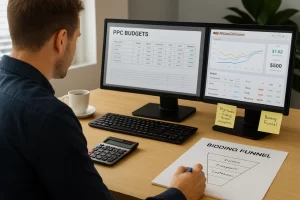Table of Contents
ToggleHave you ever searched for a local business on Google only to find the map showing an incorrect location or phone number? Or maybe a competitor appearing above you in the search results? Frustrating, right? Well, you’re not alone. Many business owners struggle with SEO for google maps and making sure their Google My Business listing appears accurately with strong visibility. But there is hope.
By following the 10 key steps discussed in this blog, you can perform Google Maps optimization and beat out the competition on the local map.

Step 1: Complete and Verify Your Google My Business Listing
Having a complete and verified Google My Business listing is a basic need for SEO. Yet many businesses don’t even have one. Sign up for a FREE GMB listing and enter all your key business information accurately. This includes your correct address, phone number, website, business hours, photos, menu/services, and other details.
Pro tip: For Shopify stores and small businesses, be sure your store location shows if you have a physical retail shop.
Verification proves you’re a legitimate business. Without it, your listing may get removed. Verify your GMB account through email, phone, or postcard options Google provides.
Step 2: Optimize Your Google My Business Categories
Categorizing your business appropriately is vital for visibility in the maps and searches related to your products/services. You can select up to 3 categories and even edit these later if your offerings change.
For example, a bookstore may choose:
- Bookstores
- Bookshops
- Stationery Stores
Step 3: Improvise Your Business Description
Your business description is prime SEO real estate providing Google better information about what you do. Craft an engaging overview that uses relevant keywords naturally to rank for searches related to your niche, offerings, location, and more.
Avoid just repeating your business name and categories. Share your story, experience, awards won, expertise areas, mission, and anything that makes you stand out.
Pro tip: Mention the keywords “SEO for Google Maps” or “SEO for Shopify stores” to target search intent.
Step 4: Add High-Quality Photos and Virtual Tours
They say a picture is worth 1,000 words. Well, Google also agrees. Visual content plays a big role in higher local rankings.
Upload exterior and interior photos showing customers what your space and offerings look like. Try capturing photos highlighting products, menu items, event spaces, staff, signage, and anything conveying the customer experience.
To perform SEO for small businesses without a storefront, share photos of your products, staff, company events, etc. Leverage Google’s free virtual tour builder to let searchers “step inside” your business virtually.
Step 5: Insert a Google Map With Your Address
Having a Google Map visually highlighting your exact location on your website boosts SEO authority significantly.
The easiest method is embedding a basic Google Map on your Contact Us page with a map marker and label at your business address. If your budget allows, work with a developer to integrate an interactive map into your website’s footer or contact section.
This displays your location consistency across platforms. It also helps differentiate you from competitors attempting to rank for your branding keywords through black hat tactics like duplicate GMB listings.
Step 6: Get Customer Reviews
Customer reviews on Google carry more credibility than almost anything in boosting local search visibility. Aim for at least 15+ recent 5-star ratings. This earns the “Loved by Customers” badge and improves favorability in the local algorithm.
Proactively request positive reviewers leave feedback through email follow-ups, printed/digital receipts, and signage in your establishment. Incentivize reviews through discounts and social media shoutouts for the best testimonials.
Step 7: Monitor and Respond to Reviews
Your customer review efforts don’t stop once the good ratings start flowing in. You need to monitor reviews continually and respond to negative reviews professionally.
Set Google alerts on your business name and regularly check your GMB listing for new comments. Address less than 5-star ratings politely, apologizing for letdowns and making things right when reasonable. Show you care with the customer-centric approach.
And more importantly, don’t forget to thank happy reviewers for their kind words. This personal touch earns major loyalty points.
Step 8: Publish Local Content and Structured Data
Increasing local SEO strength requires going beyond Google strategies like optimizing your actual website content. Craft dedicated pages targeting placement for popular searches related to your products plus your city, neighborhood, street, etc.
For example, a bakery may publish pages targeting “West Village bakery,” “custom cake Greenwich Village,” or “birthday cake deliveries near Washington Square Park.”
Include rich snippets schema and JSON-LD markup, so Google understands your offerings, location, hours, etc. This enhances appearance in the search results significantly when done correctly.
Step 9: Community Networking and Local Link Building
Beyond your digital presence, real-world networking and marketing remains critical for local authority and awareness.
Look for opportunities to land neighborhood press features, interviews on hyperlocal sites, backlinks from local directories, citations on business roundup lists, and member profiles through professional groups and associations.
Step 10: Track Analytics and Optimize
How will you know what’s working if you don’t monitor the data? Set up reporting to track key local SEO metrics month over month:
- Google My Business Insights
- Organic traffic from localized keywords
- Physical customer volume
- In-store and online conversions originating from local searches
Summary
Google Maps SEO requires mastering both digital and real-world marketing elements for local search visibility. Following this 10-step checklist will help you level up your local search game in 2025 and will help you achieve higher in-person and website traffic, branded keyword ownership, and, most importantly, profitable new customer growth.










